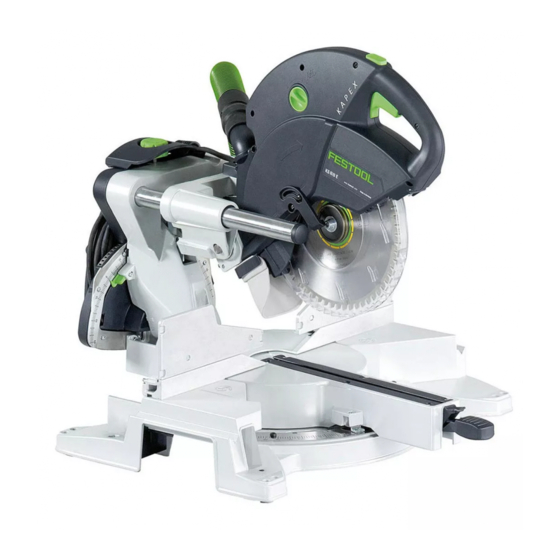
Advertisement
Quick Links
Page 1
Tool Description
A miter saw is a specialized tool that lets you make cuts at a variety of
angles. The saw has a blade mounted on a swing arm that pivots left
or right to produce angled cuts.
General Tool Safety
PPE
Always wear eye protection.
•
Wear a dust mask were appropriate
•
Wear hearing protection
•
DO NOT wear gloves
•
Do not wear loose clothing.
•
Remove Jewellery.
•
Keep hair tied up.
Consider those working around you, inform them before starting the equipment so they can
use relevant PPE, ensure there are no trip hazards and reassess the area once all cables and
extraction hoses are connected.
Do not use a power tool while tired or rushed. A moment of inattention and incorrect use of PPE
while operating power tools may result in serious personal injury and or death.
Power Tool Use and Care
Do not force the power tool. Correct settings will do the job better and more safely at the rate for
which it is designed.
Do not use the power tool if the switch does not turn it on and off. Any power tool that cannot
be controlled with the switch is dangerous and must be brought to the attention of a technician
before further use.
Use sharp and clean cutters. If the cutting tool looks blunt, worn or chipped, bring this to the
attention of a technician before continuing. Properly maintained tools with sharp cutting edges are
less likely to bind and are easier to control.
Check material condition before cutting. Remove any foreign objects such as nails or screws
from the material to prevent damaging the tool and its cutters. Do not use green or wet wood as the
water and sap content can damage the tool and its cutters.
Mitre Saw
Advertisement

Summary of Contents for Festool KS 120 KB
- Page 1 Page 1 Mitre Saw Tool Description A miter saw is a specialized tool that lets you make cuts at a variety of angles. The saw has a blade mounted on a swing arm that pivots left or right to produce angled cuts. General Tool Safety Always wear eye protection.
- Page 2 Page 2 Mitre Saw Specific Safety Rules for the Mitre Saw Be certain the mitre saw is mounted or securely placed on a level, firm work surface before using. A level and firm work surface reduces the risk of the miter saw becoming unstable or tipping. Make sure all controls and clamping handles are secured before starting any operation.
- Page 3 Page 3 Mitre Saw Functional description The Mitre saw is intended to cut wood, plastic, aluminum, and similar materials. Using the tool in contravention to this induction may lead to injury and/or death.
- Page 4 Page 4 Mitre Saw Functional description continued...
- Page 5 Page 5 Mitre Saw Dust Extraction Connect the saw to a dust extractor to reduce dust during operations on wood. NOTE Extraction must NOT be used when cutting Aluminium. Ensure the dust extraction port is facing away from others who are working in the space. Plug the power tool cable into the front of the extractor and set to full suction and Auto.
- Page 6 Page 6 Mitre Saw Power Trigger and Plunge Release The power trigger turns on the saw but also releases the motor head to plunge downward. To help prevent accidental starting of the saw, the trigger lock must be pushed to release the trigger to power the saw.
- Page 7 Page 7 Mitre Saw To stop at the one of the preset lock positions, release the mitre stop lever just before reaching the angle, the mitre stop will click as it locks into position. Can you change the spelling of Mitre in the caption?! To set the mitre angle to ½...
- Page 8 Page 8 Mitre Saw Using the Auxiliary Fence The auxiliary fence provides support for taller workpieces. The two halves of the fence can be pushed towards or away from the blade or be removed completely. Making beveled cuts requires the auxiliary fence to be moved away from the blade area. To move the auxiliary fence, lift the locking lever, slide the fence, then lower the locking lever.
- Page 9 Page 9 Mitre Saw Keep the tool clean. Dust and debris from some materials can be extremely abrasive and cause components within the tool to wear prematurely. It is important to keep moving parts cleared of abrasive dusts. Wood dust can attract atmospheric moisture and corrode the cutters and its fixings.
















Need help?
Do you have a question about the KS 120 KB and is the answer not in the manual?
Questions and answers